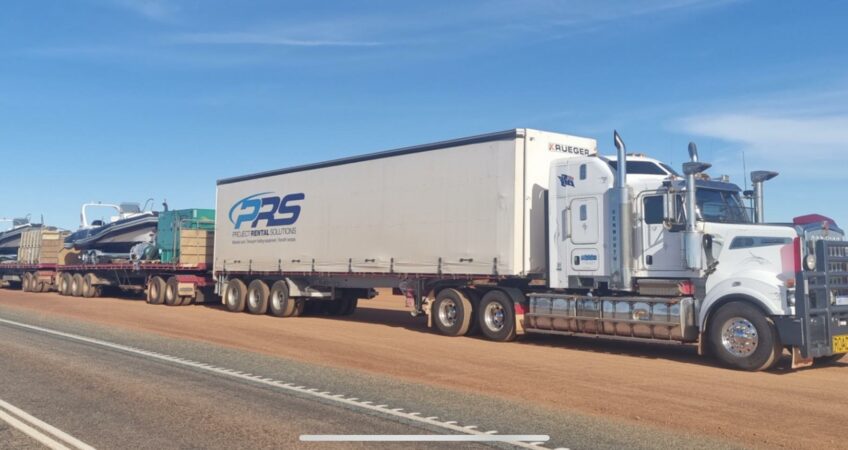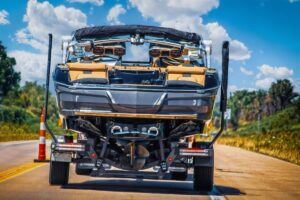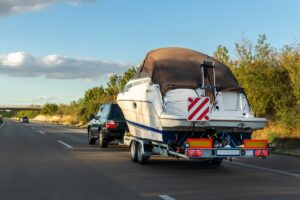
Knowing how to transport a boat involves extensive preparation, obtaining the proper permits, and strategically planning your route.
Whether you’re moving your boat to a new location or shipping it to a buyer, you’ll need to understand the complexities of transporting boats.
In this guide, we’ll answer how boats are transported in Australia, important considerations, and tips for preparing your boat for a safe, successful journey.
Understanding the Basics of Boat Transportation
Boat transport is the process of moving your vessel from one location to another.
Sometimes it’s as simple as getting it hauled out of the water and onto a trailer to drive it to a storage area for the cooler months. Or, maybe you sold a boat and need it shipped across WA or even to a different continent.
The larger the boat or the longer the distance, the more complex the transport process becomes.
The basics of how to transport a boat include:
- Choosing the appropriate towing vehicle and trailer
- Planning your route
- Knowing legal requirements and local transport regulations
- Obtaining necessary permits
- Having the proper insurance coverage
Why Transporting Boats is Different from Other Vehicles
Transporting a boat, especially oversized boats, requires a specialised trailer and the appropriate vehicle. Whereas cars can usually be transported via standard car carriers, transporting a boat involves special considerations.
Key differences between transporting a boat compared to other vehicles include:
- Moving a boat usually requires a specialised, dedicated boat trailer
- Boat transport requires varying permits
- It can be difficult to access launch points depending on the water conditions, weather, and terrain
- Boat trailers can be difficult to maneuver, especially when backing up
Different Methods of Transporting Boats
Overland Transport
Overland transport is the process of transporting a boat on public roads using a truck and specialised towing trailer. This common boat transport method is usually the cheapest.
Overland transport is ideal for short to medium distances, such as towing your boat to a boat launch. Many owners choose self-transport for overland boat transport. However, this requires a suitable towing vehicle and trailer and is generally limited to smaller boats.
For boats over 30 feet, self-transport becomes increasingly difficult and risky. Heavy or oversized boats may require a flatbed trailer and crane or lowboy trailer for transport.
Water Transport
We’ve all seen a boat being hauled on a trailer behind a truck. But how are large boats transported if they need to be shipped across the country or internationally?
The other primary method of boat transport is by water, also known as maritime transport. Boats transported by water are hauled via vessels such as container ships or cargo ships.
Water transport is ideal for transporting boats internationally, over long distances, or to an island or coastal city.
Shipping by Air
In specialised cases, boat transport by air or sea may be necessary. Air transport is typically the least common and most expensive boat transport option.
Air transport is ideal for relocating boats as fast as possible or across long distances. However, due to weight and cargo restrictions, air transport is only suitable for smaller boats.
How to Transport a Boat Safely
Preparing the Boat for Transport
Preparing your boat for a safe journey involves cleaning, draining, and securing your boat.
Here is a step-by-step breakdown of preparing your boat for transport:
- Secure any loose items or accessories on the boat to ensure nothing breaks loose or flies off the trailer during transport (i.e. radar equipment, cushions, canvas covers, gear, etc.)
- Thoroughly clean the boat to remove any dirt, debris, rubbish, and loose items
- Secure all doors, hatches, and windows to prevent them from flying open during transport
- Disconnect the boat’s battery and secure it somewhere safe during transport
- Schedule the mast to be removed and stored, if necessary, by a qualified technician
- Check the boat’s fuel level (we recommend keeping it at around a quarter full)
- Have all necessary permits, insurance documents, registration papers, and documentation organised and handy
- Protect fragile components, such as glass or electronics, with bubble wrap or padding
- Conduct a pre-transport inspection and document any existing damage (dents or scratches) or other possible issues — we recommend taking pictures to record any damage
- If you are doing self-transport, ensure your vehicle and boat have appropriate insurance coverage
Choosing the Right Trailer or Equipment
Boat size and type dictate the type and size of trailer you’ll need for transport. Heavier or oversized boats require specialised equipment and trailers. It is also imperative to have a vehicle rated to tow your boat and trailer set up.
We’ve seen too many pe
ople try hauling a boat with an undersized vehicle. This places immense stress on the towing vehicle and can result in damage to the transmission.
Legal and Regulatory Requirements
One of the most important aspects of understanding how to tow a boat is knowing all guidelines, regulations, and permits for overland transport.
You will need to carefully plan your route and research the specific requirements of each state, territory, or area you plan to travel.
Without the necessa
ry permits, you’ll face possible fines and transport delays.
Here’s a look at just some of the towing rules and regulations you need to know and follow in Australia:
- The maximum legal towing speed in Queensland, Victoria, the ACT, SA, NT, Tasmania and WA is 100km/h (where permitted)
- All jurisdictions require boats wider than 2.9 metres wide to display “Oversize” signs at the rear of the trailer and front of the towing vehicle and four flags clearly visible on the trailer that complies with Australian Standards specifications
- A tow vehicle’s low-beam headlights are required to be on during the day (however, daytime running lights are acceptable in NSW)
- You cannot travel in can’t travel in conditions where visibility is less than 250 metres or in other poor-visibility conditions, such as smoke, heavy rain, or fog
- Unless it is an urban area or you are overtaking, you cannot tow within 200 metres behind another oversized vehicle
- A yellow rotating warning light is required to be displayed at night in Queensland
And this is just the start of the extensive list of towing rules and regulations you’ll need to know and follow in WA and other jurisdictions. These rules are in place to keep you and other drivers safe.
Before towing an oversize boat, contact all relevant transportation or state departments to inquire about any permits needed, weight restrictions, and special considerations.
It may seem overwhelming, but these rules are second-nature to our crew at Australia Wide Haulage. Having safely transported thousands of tonnes of equipment and oversized boats throughout Australia, we know the ins and outs of every permit needed and how regulations differ by state and territory.
When you work with Australia Wide Haulage, we navigate the permitting process for you. We obtain all necessary permits, documents, and licenses to ensure compliance with all legal requirements.
To learn more about driving a vehicle towing a trailer, we recommend this resource: Towing a vessel by road | NSW Government.
Key Challenges in Boat Transportation
Even with a well-planned route, the right trailer, and meticulously maintained equipment, challenges can arise that make transporting a boat difficult or dangerous.
Poor weather conditions, unexpected road construction, and vehicle or trailer issues can all cause delays or difficulties during boat transport.
Size and Weight Restrictions
Even with the right tow rig and a well-planned route, you’ll need to be aware of the road laws related to oversized boat transport in WA.
Depending on the territory you drive through, certain road laws may limit when and where you can transport an oversized boat.
There are numerous restrictions on times and places you are allowed to tow an oversize boat in Australia.
For example, in Western Australia, a Class 1 Restricted Access Vehicle (RAV) Oversize Boat Transport Period Permit is required. You’ll also need side marker lights on the boat trailer no more than 2 metres apart. If your boat is wider than 2.7 metres, you’ll be subject to even more restrictions.
Along with researching state-by-state towing and oversize boat transport rules, you’ll need to know your vehicle’s towing specifications. Vehicle manufacturers list maximum towing weight and speed. You’ll also need a designated boat trailer and proper tow bar. Follow all guidelines closely to avoid accidents or damage to your vehicle or boat
If you are interested in self-transport for your boat, we recommend this helpful oversize boat towing checklist from the Guide to Towing Oversize Boats on Public Roads.
Weather and Environmental Conditions
Transporting a boat is a complex process even in ideal weather conditions. But how are boats transported during a heavy downpour, high winds, or hail?
Even something seemingly simple like a slippery boat ramp can pose serious issues for overland transport.
Professional overland boat transport is the most reliable way to get your boat safely moved from point A to B. Our specialty towing trailers and equipment are made to handle slippery roads and our drivers are trained to navigate safely despite challenging weather.
We also incorporate weather planning into the route planning process to reduce the risk of encountering poor weather.
Professional Boat Transport Services
Professional boat transport services are ideal for:
- Transporting boats over long distances
- Relocations that cross various territories where you’ll encounter different regulations, rules, and permits
- Boat owners who do not have the truck or trailer necessary for hauling their boat
- Oversized boats
- Boat owners who want the ultimate protection for their vessel during loading, transport, and unloading
Benefits of Using Professional Transport Services
If you’re researching how to transport a boat in the safest, most efficient way, a professional boat transport service is the best option.
A boat towing company that specialises in overland transport will have the equipment, experience, and insurance necessary to safely transport your boat from a marina, storage, or over long distances.
Advantages of using professional boat transport services include:
- Least amount of hassle
- Highest level of safety
- Comprehensive insurance coverage
- Expertise regarding proper weight distribution and how to safely secure your boat for transport
- Knowledge of the most efficient routes
- Ability to obtain all necessary permits and follow all rules and regulations for oversized boat transport
- Cost-effective (hiring a boat transport service can end up being cheaper than transporting the boat yourself!)
- Knowledge in safely handling difficult conditions, unexpected situations, or severe weather
- Seamless loading and unloading
You May Also Like: Cost-Effective Ways to Transport Your Car
How to Transport a Boat in WA Safely and Efficiently
Knowing how to transport a boat safely involves extensive preparation and a thorough understanding of the permits and regulations for your route.
If you’d rather start planning your next outing on the water rather than worrying how to transport a boat, our expert drivers and top-of-the-line 90 to 167-tonne haul fleet are ready for the job.
After years of reliable service, we’ve proudly built a reputation as the preferred boat logistics company in Australia. Need expert help transporting your boat safely and efficiently? Contact Australia Wide Haulage today to learn more about our specialised Boat Transport Service!


